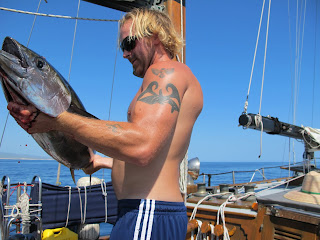
Chris and I enjoy good coffee. It is among my "future plans" to insert myself into the coffee industry in one way or another, whether as a roaster, buyer or shop owner. It has been a priority on this trip to seek out good beans and stock up when we can. Most grocery stores only stock ground coffee and we're trying to get whole beans, so the result has been that we often have to ask around to those in the know to complete our coffee mission.
The last coffee we bought was in La Cruz, locally roasted at a cafe/art gallery, and it was nice and fresh and tasty. But it is almost gone, so here in Puerto Escondido, we needed to procure some more. After cruising the two touristy strips here and coming up empty, I asked a guy on the beach if he knew where I could buy some whole coffee, and he suggested the mercado munipal. The mercado in Puerto Escondido is part farmer's market, clothing shops and just about anything else you could want. So we took a cab there and started trolling the stalls. It's pretty organized, with whole rows taken up by the same kind of stall, one of fruits and vegetables, the next of meat, prepared foods, flowers, etc. We walked around for about 20 minutes and saw no coffee vendor. So we asked one of the other vendors and she pointed us one way. We walked over to the area she had pointed out but it was more prepared food, where I'm sure coffee was available, but in its final liquid form.
About this time Chris began to get hungry (which happens approximately every 15 minutes) so we stopped to get a snack at one of the booths. After Chris finished his torta, we asked the ladies there and they pointed us down to the next aisle...we think. So we walked over an aisle or two but saw only seeds, dried beans and herbs. Then Chris said he thought she might have said the next street, so we went there too. We saw an awesome little shop where they made Oaxacan chocolat, which is a tasty beverage, but not coffee.
Then we went back to the mercado and asked the woman at the tequila stall if she knew where they sold coffee. She said something like, “Senora, mumblemumblemumble,” and made a shooing motion with her hand. So off we went in the direction which she shooed us. But we were just back to the beans and seeds stalls. A defeatist attitude began to settle over us. I pointed to a stall where I saw big bags of something stacked up, so we strolled over...to the pet food. There were also baby chickens in a cage. In a last ditch effort, we asked one of the beans and seeds guys. He picked up one of the plastic bags on his table. It was coffee, alright. It was also green.
So began our adventures in roasting. With a little help from Sweet Maria's, the internet site from which we bought our hand grinder, we learned that we could just roast in a covered pan, shaking the coffee over the flame like popcorn. So we did. It was really cool. We could hear it crack and see it grow and turn dark in front of our eyes. So now we not only have whole bean coffee, we have fresh roasted whole bean coffee. Woo hoo!
So this all illustrates two salient things we've discovered while on this little trip of ours. One: when you ask for directions, sometimes you're going to get more mixed up. Keep asking. And listen well. Two: when you want the good things in life, all the raw ingredients are there. You just have to be willing to shake it up.



















